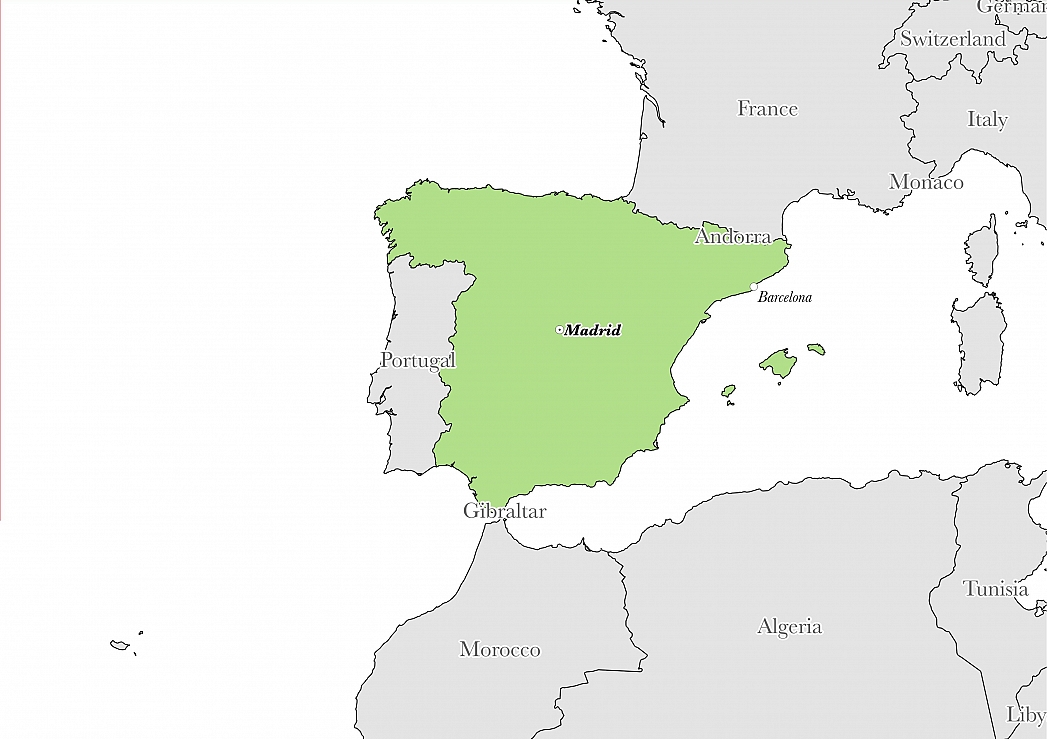Where is Spain?
Located in Southwestern Europe, Spain has a 1,953.00 km border with Andorra (63 km), France (646 km), Gibraltar (1.2 km), Portugal (1,224 km), Morocco (Ceuta) (8 km), Morocco (Melilla) (10.5 km). It has a 4,964.00 km coastline. In 2002, Gibraltar residents voted overwhelming to rejected any "shared sovereignty" arrangement with Spain. Morocco also protests some of Spain's control of coastal territories.
Spain is a European country covering 505,370.00 km2 of which 1.26% is water and 498,980.00 km2 is land. Spain has two autonomous cities - Ceuta and Melilla - and 17 autonomous communities including Balearic Islands and Canary Islands, and three small Spanish possessions off the coast of Morocco - Islas Chafarinas, Penon de Alhucemas, and Penon de Velez de la Gomera. This makes it the 51st largest country in the world and almost five times the size of Kentucky; slightly more than twice the size of Oregon. Its geographic coordinates are 40 00 N, 4 00 W and Madrid is the capital city.
The true origins of the country's name are unknown.
Its ISO code is ES.
Geography
Spain has a mean elevation of 660 m above sea level.
It has a tropical monsoon climate with northeast monsoons from December to march and southwest monsoons from June to October. Its terrain is made up of a flat plateau surrounded by rugged hills and mountains in the north.
Population
Spain has a population of 48,563,476 making it the 28th largest in the world. Much of the population can be found along the Mediterranean and Atlantic coasts.
Castilian Spanish and Catalan are both widely spoken. The ethnic makeup is described as a composite of Mediterranean and Nordic types. The majority of the population is Roman Catholic, with a large athiest minority.
Spain’s capital city, Madrid, is located in the central portion of the country and is home to some 6,240,000 inhabitants. The city, which has served as Spain’s capital since 1931, sits on the River Manzanares and holds the distinction of being the third largest urban center in Europe. Madrid is home to a wide array of historic, cultural, and educational institutions. Popular attractions include museums such as the Golden Triangle of Art, unique landmarks including the ancient Egyptian Temple of Debod as well as numerous churches such as the Church of San Nicolás. The city’s climate is Mediterranean in nature with residents experiencing cool winters and hot summers.
Read more on Spain's LanguagesThe dialing code for the country is 34.
Government
Spain is an independent country. It has been a country since 1492. Its constitution was last ratified in 1978.
The government of the Kingdom of Spain operates under a constitutional monarchy with a democratically elected legislature. While the current reigning monarch, King Felipe VI serves a predominantly ceremonial role, the head of the country’s executive branch is its prime minister (currently Mariano Rajoy). The roots of Spain’s present government date back to the adoption of constitutional reforms in 1978. The nation’s house of parliament is called Cortes Generales with the Upper House meeting in Palacio del Senado in the capital city of Madrid. The country’s Prime Minister resides in the Palace of Moncloa while the historic Royal Palace is used only for ceremonial purposes. Elections are held in Spain on both a local and national basis as well as those relating to the country’s membership in the European Union.
Read more on Spain's GovernmentEconomy
Factoring in Purchasing Power Parity, Spain's GDP is $1,690,000,000,000.00 (USD) with $36,500.00 (USD) per capita. This makes it the 16th largest economy and its citizens the 48th richest in the world. The currency of Spain is the Euro (EUR).
Its major export partners are France, Germany, and Italy. Its main exports are machinery, motor vehicles, foodstuffs, and pharmaceuticals. Its major import partners are Germany, France, and China. Its major imports include machinery and equipment, fuels, and chemicals.
Flag
Spain’s red and yellow flag can trace its origins back to its use by the country’s famed naval forces. The flag was designed by Antonio Valdés y Fernández Bazán who served as an officer in the nation’s navy. The Rojigualda also contains the nation’s official coat of arms. This symbol, along with the crown that sits atop it, pays homage to Spain’s royal history and the reign of various monarchs who over the course of its history once ruled the nation including that of King Ferdinand and Charles II. The ensign also symbolizes the age old kingdoms which united in order to form what is now the present day country of Spain.
Read more on Spain's FlagThis page was last modified on January 17th, 2018
More on Graphicmaps

Published on 2019-11-06
What is a Trade Embargo?

Published on 2019-11-04
Which Two Countries Used to Have the Same Flag?

Published on 2019-09-16
What Is the Only Two-Sided State Flag?

Published on 2019-09-16
Which Country Flag Looks Like the Texas Flag?

Published on 2019-08-29
Flags That Resemble the US Flag

Published on 2019-08-20
